| January 19, 2007

[NIST Tech Beat Search] [Credits] [NIST Tech Beat Archives] [Media Contacts] [Subscription Information]

Algae Toxin Identification Unravels Fish-Kill Mystery
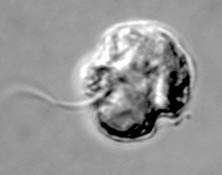 |
Differential interference contrast (DIC) image of Pfiesteria organism. The cell is about 10 micrometers across.
Credit: NOAA
View hi-resolution image |
A team of researchers from the Hollings Marine Laboratory in Charleston, S.C., has uncovered a subtle chemical pathway by which normally inoffensive algae, Pfiesteria piscicida, can suddenly start producing a lethal toxin. The discovery, reported last week in Environmental Science and Technology,* could resolve a long-standing mystery surrounding occasional mass fish kills on the East Coast.
Pfiesteria has been implicated for years in a series of otherwise unexplained episodes of mass fish death throughout its range from roughly Delaware to Alabama, particularly in the Neuse River in North Carolina and the Chesapeake Bay. The single-cell organism can experience explosive growth resulting in algae blooms in coastal waters. While it has been suspected not only in fish kills but in incidents of human memory loss and other environmental and health-related effects, no one has ever conclusively identified the actual mechanism. Attempts to grow lethal Pfiesteria in the laboratory have had inconsistent results.
The Hollings Marine Laboratory is a joint institution of the National Oceanic and Atmospheric Administration (NOAA), the National Institute of Standards and Technology (NIST), the South Carolina Department of Natural Resources, the College of Charleston, and the Medical University of South Carolina (MUSC). Lead researcher Peter Moeller of NOAA suspected that the presence or absence of heavy metals might be the missing factor accounting for Pfiesteria’s lethality, and put together a multidisciplinary research team to identify the actual toxin and the conditions under which it is produced.
The work was complicated by the fact that the suspect toxin turns out to be highly unstable, decomposing rapidly once it’s activated. Chemists from NIST and MUSC used an array of advanced spectroscopic techniques to determine that the toxin is characterized by the presence of copper-sulfur complexes. “NIST saved the day,” Moeller said, “because we were working with only microgram and submicrogram quantities of the toxin. To not only determine that a metal was indeed present but even tell us which one really broke things open.”
With that lead, Moeller’s team established that the Pfiesteria cell can produce a copper-containing exotoxin—a toxin produced external to the cell itself—possibly as a mechanism to protect itself from copper in the environment. When exposed to sunlight or other environmental factors that can destabilize it, the toxin rapidly breaks down into short-lived free radicals, highly reactive chemical species believed to be the actual lethal agents. To observe the entire chain of events requires just the right combination of copper ions, temperature, light and Pfiesteria, explaining the difficulty researchers have had in reproducing the effect according to Moeller.
Although exotoxins like that produced by Pfiesteria are not common, the researchers observe, a number of other microalgae species are known to produce them, and under the right conditions in metal-rich waters they also might produce lethal variants.
To read more, see:
* P.D.R. Moeller, K.R. Beauchesne, K.M. Huncik, W.C. Davis, S.J. Christopher, P. Riggs-Gelasco and A.K. Gelasco. Metal complexes and free radical toxins produced by Pfiesteria piscicida. Environ. Sci. Technol., ASAP Article 10.1021/es0617993 S0013-936X(06)01799-8 on line at http://pubs.acs.org/cgi-bin/abstract.cgi/esthag/asap/abs/es0617993.html.
Media Contact: Michael Baum, michael.baum@nist.gov, (301) 975-2763 

Improved Nanodots Could Be Key to Future Data Storage
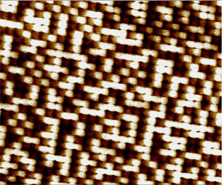 |
False-color image of 50-nanometer cobalt-palladium nanodots made with a magnetic force microscope provides both topographic and magnetic profiles. The darker dots are magnetized in the up direction (representing 1 in binary code) and the lighter dots are pointing down (representing 0).
Credit: Justin Shaw
View hi-resolution image |
The massive global challenge of storing digital data—storage needs reportedly double every year—may be met with a tiny yet powerful solution: magnetic particles just a few billionths of a meter across. This idea is looking better than ever now that researchers at the National Institute of Standards and Technology (NIST) and collaborators have made nanodot arrays that respond to magnetic fields with record levels of uniformity. The work enhances prospects for commercially viable nanodot drives with at least 100 times the capacity of today’s hard disk drives.
A nanodot has north and south poles like a tiny bar magnet and switches back and forth (or between 0 and 1) in response to a strong magnetic field. Generally, the smaller the dot, the stronger the field required to induce the switch. Until now researchers have been unable to understand and control a wide variation in nanodot switching response. As described in a new paper,* the NIST team significantly reduced the variation to less than 5 percent of the average switching field and also identified what is believed to be the key cause of variability—the design of the multilayer films that serve as the starting material for the nanodots.
Nanodots, as small as 50 nanometers (nm) wide, were fabricated using electron beam lithography to pattern multilayer thin films. The key was to first lay down a tantalum “seed layer” just a few nanometers thick when making a multilayer film of alternating layers of cobalt and palladium on a silicon wafer. The seed layer can alter the strain, orientation or texture of the film. By making and comparing different types of multilayer stacks, the researchers were able to isolate the effects of different seed layers on switching behavior. They also were able to eliminate factors previously suspected to be critical, such as lithographic variations, nanodot shape or crystal grain boundaries.
Nanodots are one of two major approaches being pursued around the world as possible means of boosting the density of magnetic data storage. The other involves using a laser to heat and switch individual bits. The ultimate solution may be a combination of the two approaches, because heat reduces the strength of the magnetic field needed to switch nanodots, according to Justin Shaw, lead author of the new paper. Considerable work still needs to be done to make this type of patterned media commercially viable: Dot dimensions need to be reduced to below 10 nm; techniques to affordably fabricate quadrillions of dots per disk need to be developed; and new methods to track, read, and write these nanoscale bits need to be devised. The NIST authors collaborated with scientists at the University of Arizona, where some of the nanodot samples were made.
*J.M. Shaw, W.H. Rippard, S.E. Russek, T. Reith and C.M. Falco. 2007. Origins of switching field distributions in perpendicular magnetic nanodot arrays. Journal of Applied Physics. 101, 023909 (2007), Jan. 15.
Media Contact: Laura Ost, laura.ost@nist.gov, (303) 497-4880


New Miniaturized Device for Lab-on-a-Chip Separations
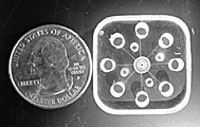 |
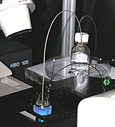 |
Core of the new NIST miniature GEMBE chemical separation device (above left) is a machined acrylic block, shown with a quarter for scale. Eight sample resevoirs for multiplexed separations form a ring around the central buffer solution port. (Smaller holes are for assembly screws.) At right: prototype in use.
Credit: NIST
View hi-resolution image (left)
View hi-resolution image(right) |
Researchers at the National Institute of Standards and Technology (NIST) have developed an elegantly simple, miniaturized technique for rapidly separating minute samples of proteins, amino acids and other chemical mixtures. A low-cost prototype device described in a recent paper* can run up to eight separations simultaneously in a space about the size of a quarter, highlighting the technique’s potential for use in microfluidic “lab-on-a-chip” systems.
Conventional electrophoresis instruments separate mixtures of electrically charged species—DNA fragments, for example—by injecting a discrete sample of the mixture at one end of a chemical race track, such as a capillary tube filled with a buffer solution, and applying a high voltage between the sample and the other end of the track. Depending on their size, charge and chemical “mobility,” the individual components of the mixture move down the track at different rates, gradually separating into individual bands. If two of the components move at very similar rates, it will require a relatively long channel—up to 50 centimeters or longer—to separate them effectively.
The new NIST technique, “gradient elution moving boundary electrophoresis” (GEMBE), works instead by opposing the movement of the mixture’s components with a stream of buffering solution flowing at a variable rate. Like salmon swimming upstream, only the most mobile components can move up the channel against the highest buffer flow rates, but as that flow is reduced gradually, lesser mobility components begin to move. A sensor placed over the channel detects each new component as it arrives,
GEMBE is ideally suited for use in microfluidic “lab-on-a-chip” devices. Components are selected by buffer flow-rate rather than distance, so the channel can be very short—less than a centimeter in NIST prototypes. It doesn’t require injection of a discrete sample, which greatly simplifies chip plumbing. By precisely controlling the flow rate, a particular component can be “parked” under the detector as long as desired to get a good signal, and the device can be adjusted easily to accommodate different separations. The device is easy to build with simple machining or molding techniques and low-cost polymers, enabling inexpensive mass production.
The technique has been validated at NIST with separations ranging from small dye molecules and amino acids to larger biomolecules, such as DNA. A prototype eight-channel GEMBE device built at NIST can produce a complete immunoassay calibration curve for insulin in a single run. NIST is applying for a patent on the method.
* J.G. Shackman, M.S. Munson and D. Ross. “Gradient elution moving boundary electrophoresis for high-throughput multiplexed microfluidic devices.” Anal. Chem., 79 (2), 565 -571, 2007. 10.1021/ac061759h S0003-2700(06)01759-8 on line at http://pubs.acs.org/cgi-bin/abstract.cgi/ancham/2007/79/i02/abs/ac061759h.html
Media Contact: Michael Baum, michael.baum@nist.gov, (301) 975-2763 

Countries Share Good Times Using GPS and the Internet
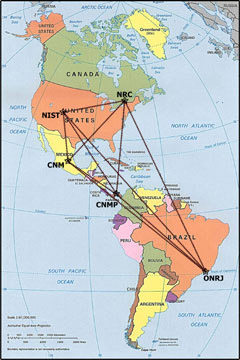 |
The Sistema Interamericano de Metrologia (SIM) time and frequency network spans a large geographical area, connecting Canada, the United States, Mexico, Panama and Brazil. The baseline from the National Institute of Standards and Technology to the Brazilian national metrology institute is 9500 km.
Credit: NIST
View hi-resolution image |
International time coordination is improving throughout the Americas thanks to a low-cost system relying on Global Positioning System (GPS) satellites and the Internet, which enables much faster time comparisons and gives small countries the opportunity to evaluate easily their measurements in relation to others and to world standards.
The time and frequency network of the Sistema Interamericano de Metrologia (SIM), or Inter-American Metrology System, began operation in 2005. The system includes national metrology institutes in member nations of the Organization of American States (OAS). The SIM network currently compares time and frequency measurements made in Brazil, Canada, Mexico, Panama and the United States. Costa Rica and Columbia are expected to join the network soon, and additional OAS members have expressed interest.
As the U.S. civilian timekeeper, the National Institute of Standards and Technology (NIST) participates in the SIM network and also calibrates other members’ equipment, which consists of a computer-based measurement system and a GPS receiver provided by OAS. Institutes simultaneously compare their time scales to clocks on the same GPS satellites, and then automatically compare their results over the Internet. Time differences can be viewed on the Web by all laboratories in the network, with updates every 10 minutes.
“Canada, Mexico and the United States now have better time coordination than ever before,” says Mike Lombardi, a NIST scientist who is a member of the SIM working group on time and frequency. The three countries’ times remained within 50 nanoseconds of each other for an eight-month period in 2006, according to a recent status report.* Measurement precision is good enough to calibrate the best regional standards.
Lombardi says the SIM network boosts the stature and capabilities of tiny metrology institutes, which cannot establish traceability to fundamental measurement units unless they make international comparisons. “Some SIM laboratories never have compared their standards to anybody before, so that’s where the real beauty of the network will come into play,” he says. “The larger laboratories also benefit because they now can see the measurement results in near real time, instead of waiting from two to seven weeks as they had in the past, using other reporting methods.”
*M.A. Lombardi, A.N. Novick, J.M. Lopez, J. Boulanger and C. Donado, “Time coordination throughout the Americas via the SIM common-view GPS network,” 30th Annual Precise Time and Time Interval Meeting, December 5-7, 2006, Reston, Virginia.
Media Contact: Laura Ost, laura.ost@nist.gov, (303) 497-4880


NIST ‘Standard Bullet’ Fights Gang Violence
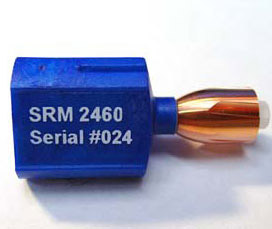 |
A NIST Standard Reference Material 2460 "standard bullet" mounted on a blue stub. Each one has six signature markings typically found in a fired bullet. SRM 2460 is intended primarily for use as a check for crime laboratories to help verify that the computerized optical equipment for bullet imaging and profiling is operating properly.
Credit: NIST
View hi-resolution image |
Researchers at the National Institute of Standards and Technology (NIST) have developed a copper bullet designed to help end criminal sprees without once being fired. Crime laboratories can use NIST’s “Standard Bullet” to optimize the settings of computerized optical imaging instruments used to match markings on fired bullets from a suspected weapon.
Analyzing bullet markings in order to trace guns used in multiple crimes, such as gang activities, is possible because a gun’s firing pin, rifling, breech face and ejection mechanism can impart unique markings, called “signatures” on fired bullets or ejected casings. Comparison (dual) optical microscopes allow forensic experts to compare signature features as small as a micrometer or one fortieth the width of a human hair. Digital imaging systems are used to gather and store bullet signatures in forensic databases, and it’s important for these systems to record the best possible images. Crime labs can test the quality of their imaging systems by taking pictures of NIST’s Standard Bullet and evaluating how well their system’s analysis of the bullet’s signature matches up with a certified signature provided by the Institute.
To make the Standard Bullet, NIST traced surface topography profiles on six master bullets fired by the Bureau of Alcohol, Tobacco, Firearms and Explosives (ATF) and the Federal Bureau of Investigation (FBI). Researchers fed the data to a computer-controlled diamond turning machine to engrave six typical bullet signatures on the standard. After machining, a specially designed chemical etching process was used to roughen the surface of the bullet to make it appear like a real bullet when observed under an optical microscope.
Earlier efforts at standard bullets produced by real guns could show minute changes in signatures due to gun wear and environmental conditions. However, since the signatures and dimensions of the NIST Standard Bullet are recorded for manufacture, subsequent copies are essentially identical. The etched and corrosion-protected NIST Standard Bullet is certified for use until June 30, 2016. In 2007, NIST hopes to produce a complementary standard for ejected casings by a different fabrication procedure. The bullet and casing reference standards will support the National Integrated Ballistics Information Network (NIBIN) goal of establishing nationwide ballistics traceability, measurement unification and quality control. NIBIN is a joint project of the FBI and the ATF. Development of the NIST Standard Bullet was sponsored by the National Institute of Justice (NIJ) through the NIST Office of Law Enforcement Standards (OLES).
For more information on NIST Standard Reference Material 2460, “Standard Bullet,” see https://srmors.nist.gov/view_detail.cfm?srm=2460.
Media Contact: John Blair, john.blair@nist.gov, (301) 975-4261 

Right Counter Height Can Improve Fingerprint Capture
Once a tool primarily used by law enforcement, biometric technologies such as fingerprint readers increasingly are being used by governments and private industry for a personal ID that can't easily be forged or stolen. But, despite their increased use, little attention has been paid to the human-system interaction that these technologies require. With fingerprint scanners and other imaging devices, for example, user behavior can affect both the quality of the image and the time required to capture it. At present. there are no guidelines for using biometric hardware and software that could lead to improved usability and interaction techniques.
As part of its role under the USA PATRIOT Act, researchers at the National Institute of Standards and Technology (NIST) conducted a study examining the effect of the work surface height of a fingerprint sensor on the quality and the time required to collect prints. NIST researchers collected five types of fingerprint images from 75 NIST employees, ranging in age from 17 to 67. Images were collected from a "left slap"; (all fingers on the left hand except for the thumb); a "right slap"; a left or right thumb; and both thumbs. Work surface heights varied from 26 inches (660 millimeters) to 42 inches (1,067 millimeters). The fingerprint scanner used in the study had a height of 6 inches (152 millimeters)—the expected height of the next generation of fingerprint scanners to be used in many federal government applications.
The researchers found that participants performed fastest using a work surface height of 36 inches (914 millimeters); and a height of 26 inches (660 millimeters) produced the highest image quality. Participants preferred a work surface height of 32 or 36 inch (813 or 914 millimeters); the 42 inch height was most uncomfortable. Seventy-six percent of the participants preferred starting with their right hands, which also made the process faster. Quality dropped dramatically when thumbprints were taken simultaneously rather than one at a time.
The study was sponsored by the Science and Technology Directorate of the Department of Homeland Security. Results are available in the report, Effects of Scanner Height on Fingerprint Capture (NISTIR 7382), at http://zing.ncsl.nist.gov/biousa/docs/NISTIR-7382-Height%20Study.pdf
Media contact: Jan Kosko, kosko@nist.gov, (301) 975-2767 

New Quartz References For Workplace Safety
Chemists at the National Institute of Standards and Technology (NIST) have developed a new set of reference materials that could contribute to significant improvements in workplace safety through more accurate measurement of the amount of quartz dust in the air.
Crystalline silica or quartz is one of the most common minerals on Earth. When finely powdered silica gets in the air it becomes a significant health hazard. Respirable quartz is associated with the development of silicosis, lung cancer, pulmonary tuberculosis and other airway diseases. The National Institute for Occupational Safety and Health (NIOSH) has estimated that at least 1.7 million U.S. workers are exposed to respirable crystalline silica in a variety of industries and occupations, including construction, sandblasting and mining (1991 data). Other industries with significant exposure include building construction and medical and dental laboratories. To help safeguard workers, the Occupational Safety and Health Administration (OSHA) enforces strict regulatory limits on the emission of respirable crystalline silica in the work place.
Monitoring silica dust in the workplace typically is done by collecting samples over a period of hours on a special air filter and using X-ray diffraction (XRD) to determine the amount of silica present in the sample. To be effective, monitoring requires accurate measurements of micrograms of silica on the filters, which in turn requires precise calibration of the measurement system. NIOSH has identified calibration errors as a significant factor in inconsistent results from different laboratories.
To help environmental laboratories perform these demanding calibrations, NIST has developed a series of Standard Reference Materials (SRMs) with precisely measured quantities of respirable quartz deposited on typical filters. The NIST materials cover the range between 5 micrograms and 1000 micrograms of quartz per filter, the typical range encountered in the field, and can be used to validate the accuracy of lab measurements needed to meet OSHA regulations. The reduction to ash technique must be used to prepare the quartz-on-filter specimens for XRD measurements. Details on SRM series 2950—2958, “Respirable Alpha Quartz on Filter Media” are available at https://srmors.nist.gov/tables/view_table.cfm?table=105-10.htm.
A related series of reference materials using cristobalite, the second-most important form of respirable crystalline silica, also is being developed. Standard Reference Materials are among the most widely distributed and used products from NIST. The agency prepares, analyzes and distributes well over a thousand different materials that are used throughout the world to check the accuracy of instruments and test procedures.
Media Contact: Michael Baum, michael.baum@nist.gov, (301) 975-2763 

Quick Links
Minutely Organized Particulars …*
National Institute of Standards and Technology (NIST) research in quantum systems and materials science at its Boulder, Colo., laboratory appears in an unusual venue at the University of Colorado’s “Art in Science | Science in Art” exhibition. The on-line, juried exhibition showcases 66 images where art and science intersect, chosen from hundreds submitted from the university’s community—the sponsors note that Colorado includes “four of the 20 highest concentrations of science and technology workers in the country.”
View “Art in Science | Science in Art” on line at http://artsci.uchsc.edu, and note in particular—
* “For Art and Science cannot exist but in minutely organized Particulars” – William Blake
|

